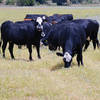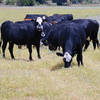

One hundred and thirty-two years ago, after looking around Texas for just the right spot, the Freeman family of Louisiana found what they were looking for in Llano County.
Through the sweat and hard work of generations past, that original country has grown exponentially into the large swath of land in north Llano County commonly known as the Freeman Ranch. The ranch, while still largely intact, is owned and ranched by several members of the family, all descendants of N.B. Freeman.
Joe Freeman, 61, is a fifth generation rancher there, keeping his family tradition alive among the changing face of agriculture in this area and throughout the country. He ranches 4,000 acres he owns or leases largely along the winding trail of County Road 414.
And as agriculture changes, Joe is happy he can do his part to keep things going and keep his family tradition alive.
“It’s hard, It’s hard,” he said. “I have a daughter who lives 200 miles away. I don’t know if they’ll ever get back up here with enough time or whatever. My son (who lives in Austin), I’m hoping will try to fill in. But you don’t know these things.
“When I was raised, we were kind of trained - you protect your country, you take care of it, and you pass it on. Those people I named a while ago, those are the people who slugged it out and worked their butts off out here. I was just born into it. I’d be pretty counterfeit to just cash it in and walk away.”
The Freeman Ranch started in 1884, when N.B. Freeman and his wife, Elizabeth, bought the first patch of ground. N.B.’s elderly parents also came with them. They eventually bought more land, and then Joe’s grandfather, Nolan, bought even more.
Although most of that land remains in family hands, it is owned by different members of the family. In addition to Joe, part of the land is owned by Jil Freeman, who was married to his late brother, Dale, and her three sons; and his cousins, Bart Freeman and Don Paul Freeman, in addition to cousins Steve Duncan, Joe Allen Duncan and Lester Duncan.
“We still think of it, in the greater sense, as the Freeman Ranch, but everyone has pretty much, when they received their country, just ranched it their own,” Joe said.
What is a modern ranch? Carol, Joe’s wife, describes working a modern ranch as “using new innovations and concepts to improve production and conserve the land.”
“I spend nearly every morning spraying brush. Another typical modern ranch, they may not be doing any of that,” Joe said. “I get some extra money, and I’m rebuilding some fence. I don’t know if they’re doing that or not. Most ranches now have at least some sort of improved grassfield on it for hay production or grazing.
“We used to have a lot of windmills out here. They’re pretty hard to maintain. Solar pumps have come into favor. They’re kind of expensive, but I think in the long run, they’re probably the thing to do."
As for the cattle, Joe said most are now Angus-influenced.
“When I was growing up, everything was Hereford cows,” Joe said. “That’s pretty much changed. I keep some Hereford bulls just for cross breeding, but it’s pretty rare to see a solid set of Hereford cows anywhere.”
As in any field or industry, technology has greatly changed, too. Joe uses a truck as he pulls a trip hopper full of feed and bounces across the acres. Those cows not too deterred by the hot summer sun come to him for feed, while others remain in the shade. He uses different sprays and methods to rid the ranch of various forms of cactus and prickly pear. And he has even had various parts of the land sprayed from a helicopter.
Things have changed a lot since Joe’s father, Carl, farmed just over half a century ago.
“I remember stuff in the late ‘50s. Of course, they had pickups, but there wasn’t anything like gooseneck trailers or any of that stuff,” he said. “You’d see a pickup with sideboards on it and a horse in the back. Everyone hired trucks. There used to be trucking companies here. You hired trucks to come out and haul your cattle.”
The methods of transportation have been one of the biggest changes.
“When I was growing up, you’d ride a horse all the time,” Joe said. “Now we’ve got pickups and trip hoppers, get in a Polaris Ranger to go check the water gaps instead of putting a saddle on a horse and going down there. I keep a bunch of horses, but I don’t ride them like I used to. We’ve kind of got a little more domesticated.”
Other changes include the kinds of production on the ranch.
“(The Freeman family was) farmers over there (in Louisiana), but here, a large percentage of this ranch was paid for with hogs, besides cattle,” Joe said. “I’m sure they came here for the oak trees and the acorns for those hogs. All these old fields, there’s fields all over this ranch that they used to farm. And sharecroppers lived in houses in there. They farmed cotton. Cherokee had a gin, all these little places do. But they raised a lot of peas and stuff to fatten those hogs up, and they were really good with the hog dogs.”
A lot of diversification remained, even into the generation before Joe.
“My dad (Carl) had goats, sheep, hogs and cattle,” he said. “You did anything to make a buck.”
“Then they had a garden and a milk cow,” Carol added.
Although diversification remains, it takes a different form now. Instead of tending to hogs and sheep, many who ranch have full-time jobs in other fields. Some live and work in other places, and return home on the weekends. For instance, Joe worked years for the state soil and water conservation office, including many years in south Texas. While he was away, he tried to make it back to Llano County every weekend. He and his family moved back to the county in 1988.
“That’s kind of part of what I call the perfect storm, is when grandpa’s gone and you don’t have enough country to make a living on, which very few people here ranch solely,” Joe said. “Everyone works for the newspaper, teaches school, county agent, soil and water conservation, policeman – something. This is more supplemental. A lot of it is tradition.”
Despite the changes, a lot of the ranch is pretty much the same. Joe and Carol operate the ranch on their own, with a little help from their children. The only added help is for working or shipping calves.
“Except for a handful of new fences that have been built, a whole lot of this place looks the same as it did when I was a kid,” he said. “We’re pretty lucky out here, with it all being family around us. It hadn’t changed that much.”
Other changes have been subtle, noticed mainly by those in ranching as society has changed over the years. Joe said it was rare to leave the ranch before some in his generation did.
“Again, that’s because things are getting smaller and you have to make a living,” he said. “This old country will only let you take so much out of it. It’s pretty fragile. You can only run so many cattle on it. You can only kill so many deer.”
Carol is heartened that many longtime ranch families keep things going, including many in Llano County.
“There’s some old family names here like Slator and Bauman...they’re old, old families who have been here for generations, that are ranchers, and it seems to me like a lot of those are the ones that are holding on as tight as they can. Like, their kids will continue and try to hold onto it,” she said.
There’s also changes in the use of land, something Joe noticed a lot while on the road for the soil and water conservation board.
“On my job traveling, I saw so much change. It was kind of spooky,” he said. “You’d drive from here to Bandera, I might drive it twice a week. You’d see a new entrance going in every time you went down the road. You’d look over there on a hill, and there’d be a shiny rooftop. That wasn’t there last week. Hell, there’s one over there. And you’d say, ‘Oh, my gosh. What’s going to be left?’”
As the land changes, so do the people. Joe is now part of the oldest generation, after the last of the previous generation – his uncle, Gordon, known to everyone as Ick – died last year.
“Those people pretty much raised us,” Joe said. “My dad died when he was only 48 years old. He had cancer. I was 9, my brother was 7. My mom raised us, but country-wise, my aunts and uncles, they’re the ones who kind of took us under their wings, taught us stuff, showed us stuff.”
“The thing I hate to see is every generation loses knowledge,” he added. “I don’t know half of what my dad knew, my son doesn’t know half of what I know. All this stuff will run its string out one of these days, I don’t know.”
As the years have gone on, keeping the tradition alive is something that weighs heavily on Joe’s mind. In the end, he knows he can only do so much.
“I made up my mind a long time ago that I’m going to do what I’m going to do right now, try to hang on to as much of the old stuff as you can,” he said. “Anything new worth having technology wise or knowledge wise, try to pick up stuff that you think will work for you, and do the best you can while you’re here – then it’s someone else’s problem. What else can you do?”




